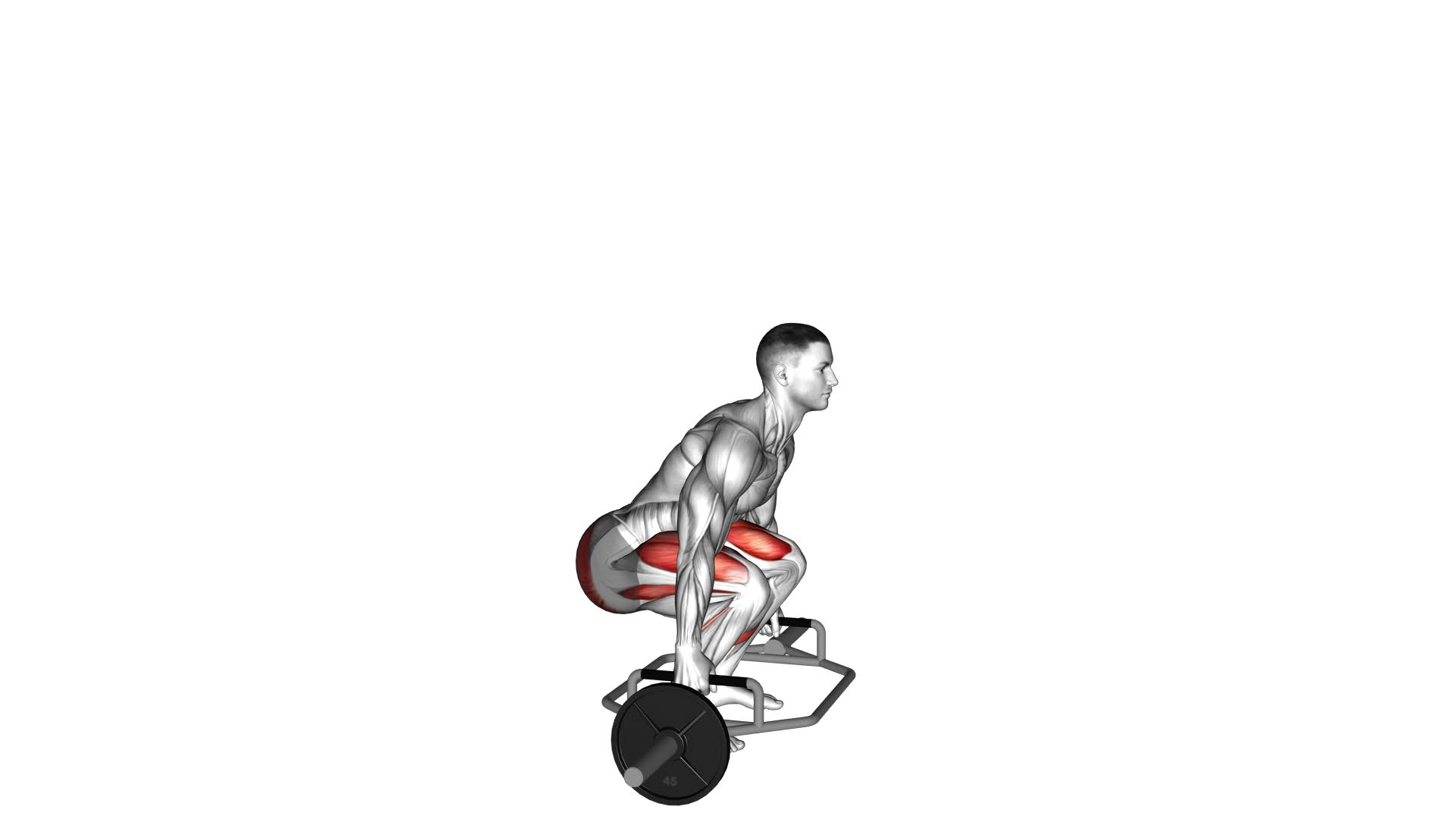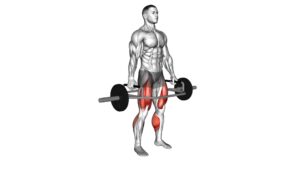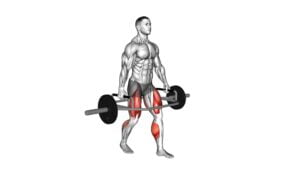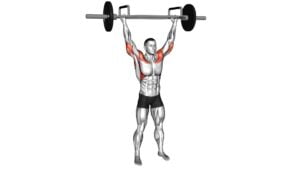Trap Bar Squat – Video Exercise Guide & Tips

Looking to improve your squatting technique? Check out this video exercise guide and tips for the trap bar squat.
Watch This Exercise Video
Learn how to maximize the benefits, nail the proper form, and avoid common mistakes.
With variations and modifications, you can tailor the exercise to your fitness level.
Plus, discover tips for increasing intensity and progression.
Get ready to take your squat game to the next level with this informative and detailed guide.
Let's get started!
Key Takeaways
- Trap bar squat targets multiple muscle groups simultaneously
- Proper form and technique are crucial for performing trap bar squats effectively
- There are various variations and progressions that can be incorporated to challenge muscles and improve performance
- It is important to avoid common mistakes and prioritize safety considerations while performing trap bar squats.
Benefits of Trap Bar Squats
Get ready to experience the numerous benefits of trap bar squats. This exercise isn't only great for building strength and muscle, but it also offers several advantages when it comes to injury prevention and muscle activation.
One of the key benefits of trap bar squats is their ability to help prevent injuries. Unlike traditional barbell squats, trap bar squats place less stress on your lower back. The design of the trap bar allows you to stand more upright, reducing the risk of lower back strain. This makes it a safer option for individuals with lower back issues or those who are new to squatting.
In addition to injury prevention, trap bar squats also provide excellent muscle activation. This exercise targets multiple muscle groups simultaneously, including the quadriceps, hamstrings, glutes, and calves. The trap bar allows for a more natural movement pattern, which helps to engage these muscles more effectively. As a result, you can expect to see improvements in your overall lower body strength and muscle development.
Proper Form and Technique
To ensure proper form and technique during trap bar squats, focus on maintaining a neutral spine and engaging your core throughout the exercise. Here are three important aspects to keep in mind:
- Keep your back straight: Avoid rounding or arching your back during the exercise. Imagine a straight line from your head to your tailbone, and actively engage your core muscles to support your spine.
- Maintain proper foot placement: Position your feet shoulder-width apart with toes pointed slightly outward. This will create a stable base and allow for proper alignment of your knees and hips throughout the movement.
- Use proper breathing technique: Inhale deeply before descending into the squat, and exhale as you push through your heels to stand back up. This controlled breathing pattern helps stabilize your core and provides more power during the exercise.
Common misconceptions about trap bar squats include thinking that it's solely a lower body exercise. While it primarily targets the muscles of the legs, it also engages the core, back, and upper body muscles. Additionally, some people mistakenly believe that leaning forward excessively is necessary. However, maintaining an upright torso promotes proper form and reduces the risk of injury.
With a solid understanding of proper form and technique, you can now explore variations and modifications of the trap bar squat to add variety and challenge to your workouts.
Variations and Modifications
Explore different variations and modifications of the trap bar squat to add variety and challenge to your workouts.
There are several alternative equipment options that you can use to perform this exercise. One option is the hex bar, which is similar to the trap bar but has a different shape. This variation allows you to maintain a more upright posture during the squat, putting less stress on your lower back.
Another option is the dumbbell trap bar squat, where you hold a dumbbell in each hand instead of using a barbell. This variation can help improve your grip strength and increase the stability required to perform the exercise.
When it comes to targeted muscle groups, the trap bar squat primarily works your quadriceps, hamstrings, glutes, and calves.
However, you can modify the exercise to place more emphasis on specific muscle groups. To target your quadriceps more, you can perform a high-bar trap bar squat by positioning the bar higher on your traps. This variation will require more knee flexion and place greater stress on your quads.
To focus on your glutes and hamstrings, you can try a low-bar trap bar squat by positioning the bar lower on your back. This variation will require more hip flexion and put more emphasis on your posterior chain.
Common Mistakes to Avoid
Now let's talk about some common mistakes to avoid when performing the trap bar squat.
- Rounded back: One of the most common mistakes is rounding your back during the trap bar squat. This puts excessive strain on your spine and can lead to injuries. To correct this, focus on keeping your chest up and maintaining a neutral spine throughout the movement.
- Knees caving in: Another mistake to avoid is allowing your knees to cave inwards. This can put stress on your knee joints and increase the risk of injury. To correct this, make sure to push your knees outwards during the squat and engage your glutes and hips to maintain proper alignment.
- Lack of depth: Many people tend to perform shallow squats, which limits the effectiveness of the exercise and can lead to muscle imbalances. To avoid this, aim to squat to at least parallel or even lower, ensuring that your thighs are parallel to the ground. This will engage your muscles fully and promote better overall strength and stability.
By correcting these common mistakes and paying attention to your form and posture, you can maximize the benefits of the trap bar squat while minimizing the risk of injuries.
Remember to always listen to your body and seek guidance from a qualified trainer if needed.
Tips for Increasing Intensity and Progression
To increase the intensity and progression of your trap bar squat, incorporate weighted variations into your workout routine. One way to do this is by gradually increasing the weights you use. Start with a weight that challenges you but still allows you to maintain proper form. As you become more comfortable and stronger, gradually increase the weight in small increments. This will help to continually challenge your muscles and promote growth.
Another tip for increasing intensity is to incorporate advanced techniques into your trap bar squat routine. One such technique is the pause squat. During this variation, you pause in the bottom position of the squat for a few seconds before returning to the starting position. This helps to increase muscle tension and build strength.
Additionally, you can try incorporating tempo variations into your trap bar squats. This involves changing the speed at which you perform the exercise. For example, you can perform a slow eccentric phase (lowering phase) of the squat, followed by an explosive concentric phase (raising phase). This variation helps to target different muscle fibers and increase the overall intensity of the exercise.
Frequently Asked Questions
Can Trap Bar Squats Help Improve My Vertical Jump?
Trap bar squats are a great exercise to improve your vertical jump. By focusing on explosive movements and engaging your lower body muscles, trap bar squats help you develop the power and strength needed for a higher jump.
Additionally, they provide a great alternative to traditional squats, as they place less strain on your lower back.
Incorporating trap bar squats into your training routine can greatly enhance your explosiveness and contribute to a higher vertical jump.
Are Trap Bar Squats Suitable for Beginners?
Trap bar squats are a great exercise for beginners. They provide numerous benefits, such as improving strength and building muscle in your lower body. When performing trap bar squats, it's important to focus on proper form to ensure safety and maximize results.
This includes keeping your back straight, lowering your hips until they're parallel to the ground, and pushing through your heels as you stand back up. With practice and proper guidance, beginners can safely and effectively incorporate trap bar squats into their workout routine.
Can Trap Bar Squats Be Performed With an Injury?
You may wonder if trap bar squats can be performed with an injury. The answer depends on the specific injury.
If you have a sprained ankle, it's best to avoid trap bar squats altogether, as the movement can put strain on the ankle.
However, if you have a shoulder injury, there are some modifications you can make to still perform trap bar squats safely.
It's important to consult with a medical professional or physical therapist for personalized guidance.
How Often Should Trap Bar Squats Be Incorporated Into a Workout Routine?
Incorporating trap bar squats into your workout routine can provide numerous benefits. They target multiple muscle groups, including your quads, hamstrings, and glutes, making them a great compound exercise.
Additionally, trap bar squats are easier on your lower back compared to traditional barbell squats.
To maximize the benefits, aim to include trap bar squats in your routine 2-3 times per week. Remember to start with lighter weights and gradually increase as you become more comfortable and confident with the exercise.
Are There Any Specific Warm-Up Exercises Recommended Before Performing Trap Bar Squats?
Before performing trap bar squats, it's important to warm up your body properly. Engage in pre-squat stretches to increase flexibility and mobility in your hips, quads, and hamstrings.
Incorporate activation exercises like bodyweight squats or lunges to activate the muscles you'll be using during the trap bar squat. This will help prevent injuries and ensure that your body is prepared for the exercise.
Taking the time to warm up properly can greatly enhance your performance and results.
Conclusion
In conclusion, trap bar squats are a highly effective exercise for building strength and muscle in the lower body. They offer numerous benefits, such as reduced strain on the lower back and increased quadriceps activation.
By using proper form and technique, avoiding common mistakes, and gradually increasing intensity, individuals can maximize the benefits of trap bar squats and see improvements in their overall fitness level.
Incorporating variations and modifications can also help target specific muscle groups and prevent plateaus in progress.

Author
Years ago, the spark of my life’s passion ignited in my mind the moment I stepped into the local gym for the first time. The inaugural bead of perspiration, the initial endeavor, the very first surge of endorphins, and a sense of pride that washed over me post-workout marked the beginning of my deep-seated interest in strength sports, fitness, and sports nutrition. This very curiosity blossomed rapidly into a profound fascination, propelling me to earn a Master’s degree in Physical Education from the Academy of Physical Education in Krakow, followed by a Sports Manager diploma from the Jagiellonian University. My journey of growth led me to gain more specialized qualifications, such as being a certified personal trainer with a focus on sports dietetics, a lifeguard, and an instructor for wellness and corrective gymnastics. Theoretical knowledge paired seamlessly with practical experience, reinforcing my belief that the transformation of individuals under my guidance was also a reflection of my personal growth. This belief holds true even today. Each day, I strive to push the boundaries and explore new realms. These realms gently elevate me to greater heights. The unique combination of passion for my field and the continuous quest for growth fuels my drive to break new ground.







